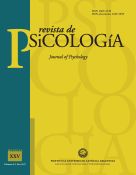Please use this identifier to cite or link to this item:
https://repositorio.uca.edu.ar/handle/123456789/6092| Título: | El Experimento de la Golosina de Mischel a la luz de las teorías neo-conductista y psicoanalítica Mischel's Marshmallow experiment analyzed from the neo-conductist and psychoanalistic theories |
Autor: | Germano, Guadalupe Brenlla, María Elena |
Palabras clave: | Freud, Sigmund, 1856-1939; Mischel, Walter; PSICOLOGIA; NEOCONDUCTISMO; PSICOANALISIS; PLACER; IMPULSIVIDAD | Fecha de publicación: | 2017 | Editorial: | EDUCA | Cita: | Germano, G., Brenlla, M. E. (2017). El Experimento de la Golosina de Mischel a la luz de las teorías neo-conductista y psicoanalítica [en línea]. Revista de Psicología, 13(25). Disponible en: http://bibliotecadigital.uca.edu.ar/repositorio/revistas/experimento-golosina-mischel-luz-teorias.pdf [Fecha de consulta:....] | Proyecto: | El experimento de la golosina a la luz de las teorías psicoanalítica y neo-conductista y sus posibles aportes al desempeño escolar y social | Resumen: | Resumen: El Marshmallow Experiment fue realizado por Mischel a partir de 1957 con el objetivo de analizar la capacidad de los niños para demorar la gratificación. Según Mischel los niños pequeños que pueden lograr una demora de la gratificación auto-impuesta son quienes en su adolescencia obtendrán mejores resultados en los planos académico y social. En la teoría propuesta por Freud se considera que los niños no podrían desarrollar un control de los impulsos autoimpuesto. Mischel, considerando los resultados obtenidos, pensaba haber interpelado la hipótesis freudiana del control de los impulsos en niños. Pero, las distintas réplicas de las pruebas, realizadas por el propio Mischel, indican que el 70% de los niños no pudo demorar la gratificación, mientras que solo el 30% logró hacerlo. Se concluye entonces que los estudios dentro del paradigma Mischel parecen confirmar más que poner en duda las ideas de Freud. Abstract: The Marshmallow Experiment done by Mischel since 1957, was intended to analyze delay of gratification in children. Mischel considered that kids that can achieve the ability to delay gratification, are those who can achieve better academic and social results. On the other hand Freud propose the theory that children can not achieve this goal. Mischel, taking into account different investigations, thought that he was questioning Freud´s theory of impulse control in children. However, the different tests results made by himself show that 70% of the children could not delay gratification, while only 30% could. As a result, Mischel´s investigations seem to confirm and not question Freud´s ideas. |
URI: | https://repositorio.uca.edu.ar/handle/123456789/6092 | ISSN: | 1669-2438 | Disciplina: | PSICOLOGIA | Derechos: | Acceso Abierto | Fuente: | Revista de Psicología, 13(25), 2017 ISSN 1669-2438 ISSN-electrónico 2469-2050 |
| Appears in Collections: | RdP - 2017 Vol. 13 nro. 25 |
Files in This Item:
| File | Description | Size | Format | |
|---|---|---|---|---|
| experimento-golosina-mischel-luz-teorias.pdf | 608,12 kB | Adobe PDF |  View/Open |
Page view(s)
3,932
checked on Apr 30, 2024
Download(s)
2,859
checked on Apr 30, 2024
Google ScholarTM
Check
This item is licensed under a Creative Commons License

